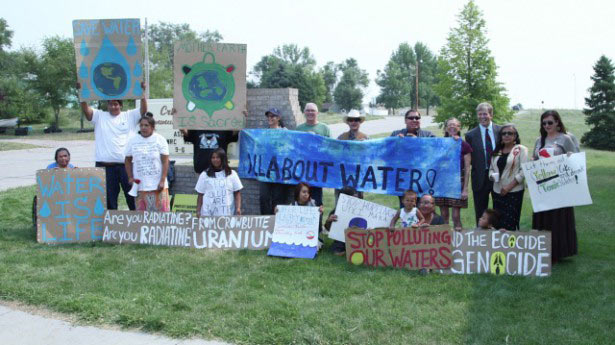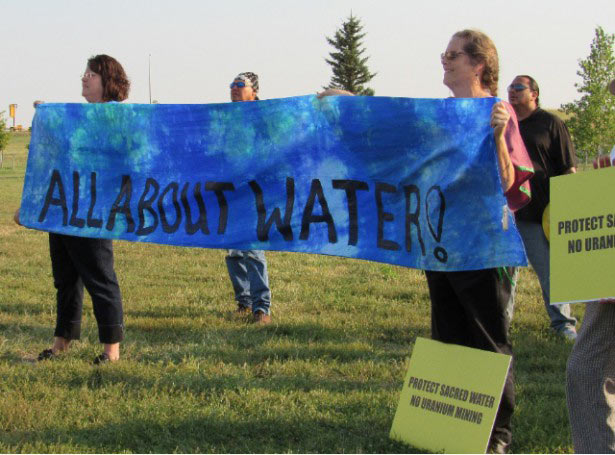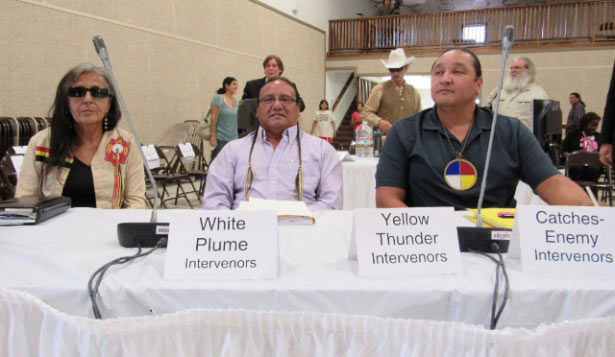
With a population of around 1,000 people, the rural town of Crawford, Nebraska was an unlikely setting for a federal hearing, but it became the site of one in late August thanks to the dogged determination of a group of Lakota and environmental activists, as well as geologists, hydrologists and lawyers – all of whom have been fighting the permit renewal of a uranium mine located in town.
The region is ripe with stories from the brutal Indian wars, when Lakota and neighboring tribes fought over western expansion. Today, this intersection of frontier America and Native resistance is a battleground in the war between environmental advocates and energy corporations, only this time allies from all sides are joining forces in the effort to protect their water.
The Crow Butte Resources, or CBR, uranium mine is comprised of thousands of wells at the base of Crow Butte, a sacred site located within Lakota treaty territories. For the past couple decades CBR has mined uranium using the in situ leach process, which injects water under high pressure into aquifers, extracts uranium ore, and then processes it into yellow cake. Each year 700,000 pounds of uranium is produced here and shipped to Canada, where it is sold on the open market. CBR has applied for a permit renewal and expansions to three neighboring sites.
Cindy Meyers, a rancher and resident of central Nebraska, drove four hours to attend evidentiary hearings regarding the renewal of the mine’s permit. It’s not unusual for Meyers to travel with her own water, which she gets directly from a well on her land that’s tapped into the Ogallala aquifer – considered the largest, underground freshwater source in the world, covering eight states from South Dakota to Texas. CBR uses Ogallala water to mine the uranium. “I keep bottles of the aquifer water in a cooler in my car,” Meyers said. “This is what water is supposed to taste like. We call it sweet water.” She notes the absence of a chemical taste often found in other drinking water. Cindy shares a large jar with her ally Debra White Plume. The two women met during their work to stop the Keystone XL pipeline in 2011. Both women share an understanding that once water is contaminated it can’t be restored and a belief that pure water is worth protecting at all costs.
 Debra White Plume (second from right) stands with the Sisterhood to Protect Sacred Water, lawyers and other supporters fighting to shut down Crow Butte Mine. (Photo: WNV / Rosy Torres)
Debra White Plume (second from right) stands with the Sisterhood to Protect Sacred Water, lawyers and other supporters fighting to shut down Crow Butte Mine. (Photo: WNV / Rosy Torres)
Debra White Plume is a Lakota grandmother who was raised on the treaty territories of the Pine Ridge Reservation located across the border in South Dakota. She shares the Lakota worldview that water is sacred. About 10 years ago, White Plume began to notice a rise in illnesses and premature deaths among her neighbors. She heard about wells testing high for radiation, arsenic and lead. This information concerned White Plume, who lives on hundreds of acres of family land and relies on her wells for drinking water. She is an experienced researcher and organizer from decades spent protecting the nearby Black Hills, sacred sites and preserving the Lakota way of life. During her research, through ceremonies, and prayer, she connected local contamination to the Crow Butte uranium mine located just outside reservation lands.
Early in 2008, White Plume was one of 11 individuals and organizations, including the Oglala Sioux Tribe, who filed to prevent the Nuclear Regulatory Commission, or NRC, from issuing a permit renewal to Crow Butte Resources. It’s been a long, slow process of submitting documents, waiting on environmental impact studies and other delays. The hearing was the final step needed for the Atomic Licensing Board – which rules over the NRC – to make its determination on the permit. Under scrutiny were nine contentions raised by the Consolidated Interveners, as the plaintiffs are called. The contentions included the lack of scientific evidence used in the permit application, the contamination of rivers and aquifers, connections between the mine and the nearby Pine Ridge Reservation, insufficient cultural surveys and consultation with the Oglala Sioux Tribe, the use of outdated and cherry-picked science, and insufficient groundwater restoration plans.
Seven years after filing the injunction, White Plume sat in the Crawford Community Center, waiting her turn to be sworn in as an expert witness. She stood with her right hand clasped around the jar of water Meyers had given her just a few minutes earlier. “Could you set your water down for a second, so you can raise your right hand?” Judge Gibson asked. “I am raising my right hand,” White Plume responded, continuing to hold the water. The judge proceeded to swear in White Plume, who gave her “oath to the truth” on water.
Grouped together among the rows of empty seats were about a dozen CBR employees, handfuls of Lakota from the nearby Pine Ridge Reservation, a few elders from Crawford, and women from the Sisterhood to Protect Sacred Water – a local group concerned about long-term environmental, health and family issues resulting from the mine.
Local resident Nancy Kile was born and raised in Crawford and now lives 20 minutes east of town. “In 1991 and 1992, when CBR approached the town, we were still grieving the flood of our river and a big fire that damaged the area,” she recalled. “A person died in that flood. It was a big deal for our community.” Nancy believes the company preyed on the townspeople’s grief and made a lot of false promises.
Older women were eager to share that they have been fighting CBR since their arrival in the town. “They promised us good and fair leases, that they would only stay 20 years and that they would leave the water and land exactly as it was when they arrived,” recalled one grandmother who was urged by her family not to give her name. “They are trying to renew their permit and expand to three more sites. So, we know they lied to us.”
 Colleen Brennan and Nancy Kile of the Sisterhood to Protect Sacred Water rally outside the Nuclear Regulatory Hearings in Crawford. (Photo: WNV / Rosy Torres)
Colleen Brennan and Nancy Kile of the Sisterhood to Protect Sacred Water rally outside the Nuclear Regulatory Hearings in Crawford. (Photo: WNV / Rosy Torres)
A few months ago, Kile and her sister Colleen Brennan grew tired of the lies they heard around town and founded the Sisterhood to Protect Sacred Water in order to give women a voice in the uranium debate. The two sisters noticed how men and youth talked about money and tax benefits when they discussed the uranium mill; and older women discussed health and human welfare, questioning high rates of cancer and premature deaths. The Sisterhood was inspired by the success of others, including White Plume and the Clean Water Alliance, who are fighting off efforts by Powertech/Azarga to open a uranium mine near the Black Hills. The Sisterhood spent the summer organizing the community, hosting screenings and educational events where people could safely share mine facts and concerns. They raised money to purchase “Protect Sacred Water, No Uranium Mining” yard signs and placed them around town. “We had some workers intimidate our allies, who put signs in their yard right in town. They immediately started calling and threatening their jobs, their persons,” Kile said.
She lamented the lack of turnout by the local community at the hearings. “You would think it would be packed, but people are isolated in this community around the uranium milling,” she said. “It’s like a culture of silence. People are scared. They are worried about being shunned by families. They’re worried about their jobs.” Many in Crawford are self-employed and spoke off the record of CBR employees visiting their businesses to give reminders of their patronage and that it would be best to avoid the hearing. Others mentioned being told that Indians were coming to town to cause problems or incite violence.
White Plume sympathized with the fear of Crawford residents. “The uranium corporation has been here long enough to embed itself in the community as an economic support, while holding people in economic bondage in terms of choosing between a job and fresh, uncontaminated water,” she said. Nevertheless, White Plume, who has worked for the last decade to educate her family and community about the dangers of uranium mining, sees the issue as cut and dry. “You’re either for it or against it.” White Plume notes there are other ways to get energy – wind, solar and industrial hemp – but there is no way to filter radiation in water.
Kile likened the situation to what she’s experienced in her life working with domestic violence survivors, saying, “No one wants to know. Denial is so deep. And then people are ashamed because there are experts here who know what’s going on.”
The late summer heat and a faulty air conditioner made the community center stuffy. Nevertheless, the three Atomic License Board judges spent careful time unraveling CBR’s permit application, often expressing concern over the lack of tribal consultation, faulty cultural site surveys, use of outdated science (some geological models were from 1937), or tornado calculations from 100 miles away.
Tom Ballanco, a lawyer for the plaintiffs, explained that the NRC’s role is to protect the public’s safety and security when it comes to handling this dangerous and toxic material. “The NRC is tasked with monitoring and minimizing any risks associated with uranium and having such a dire responsibility, we feel like they need to pay more attention than we’ve seen in the past,” he said. Ballanco went on to note that “in a somewhat controversial move” the NRC staff has already issued the license in advance of the ruling.
 Debra White Plume (with Lakota cultural experts) prepares to testify at the Nuclear Regulatory Commissions’ hearings. (Photo: WNV / Rosy Torres)
Debra White Plume (with Lakota cultural experts) prepares to testify at the Nuclear Regulatory Commissions’ hearings. (Photo: WNV / Rosy Torres)
White Plume felt the hearing was thorough, saying, “I didn’t expect the Atomic Licensing Board to go to the levels they did. I’m really pleased with how they peeled away the layers of the onion as to the NRC involvement with Cameco Corporation [the parent company to Crow Butte Resources]. To me it appeared as an alliance and collaboration, versus the NRC being a public protector of health and water in the United States.”
White Plume is optimistic that the townspeople will learn of the dangers of the uranium mine, its impact on their water and the future of their town. “I have a lot of hope that they lose fear, take courage and develop the sense that they are obligated to question authority,” she said. “In this town that means [questioning] Cameco and the NRC.”
The Atomic License Board judges will host a conference call in mid-October to answer remaining questions. Although the NRC gave preliminary permit approval to CBR, the judges have the final ruling, which is expected to be granted in early spring.
Kile believes people will become more involved with the Sisterhood once they are educated. She will share information with those who missed the hearing. Kile said their work will take place at old-fashioned kitchen tables, and involved listening to stories, reading handouts, and watching video recorded at the hearing. She recognized that trust is necessary to empower the town to stand up to the mine. “Our town has been silenced,” she said. “Silence is violence in this community. That’s what it feels like to me. It feels like they are raping my homeland.”
Kile was emotional as she shared her hope for the community, which is to see it “grow and show up for each other.” Ultimately, she wants people to feel safe and come out. If that happens, she explained, “We will continue to grow resistance and shut that thing down.”
Join us in defending the truth before it’s too late
The future of independent journalism is uncertain, and the consequences of losing it are too grave to ignore. To ensure Truthout remains safe, strong, and free, we need to raise $50,000 in the next 9 days. Every dollar raised goes directly toward the costs of producing news you can trust.
Please give what you can — because by supporting us with a tax-deductible donation, you’re not just preserving a source of news, you’re helping to safeguard what’s left of our democracy.